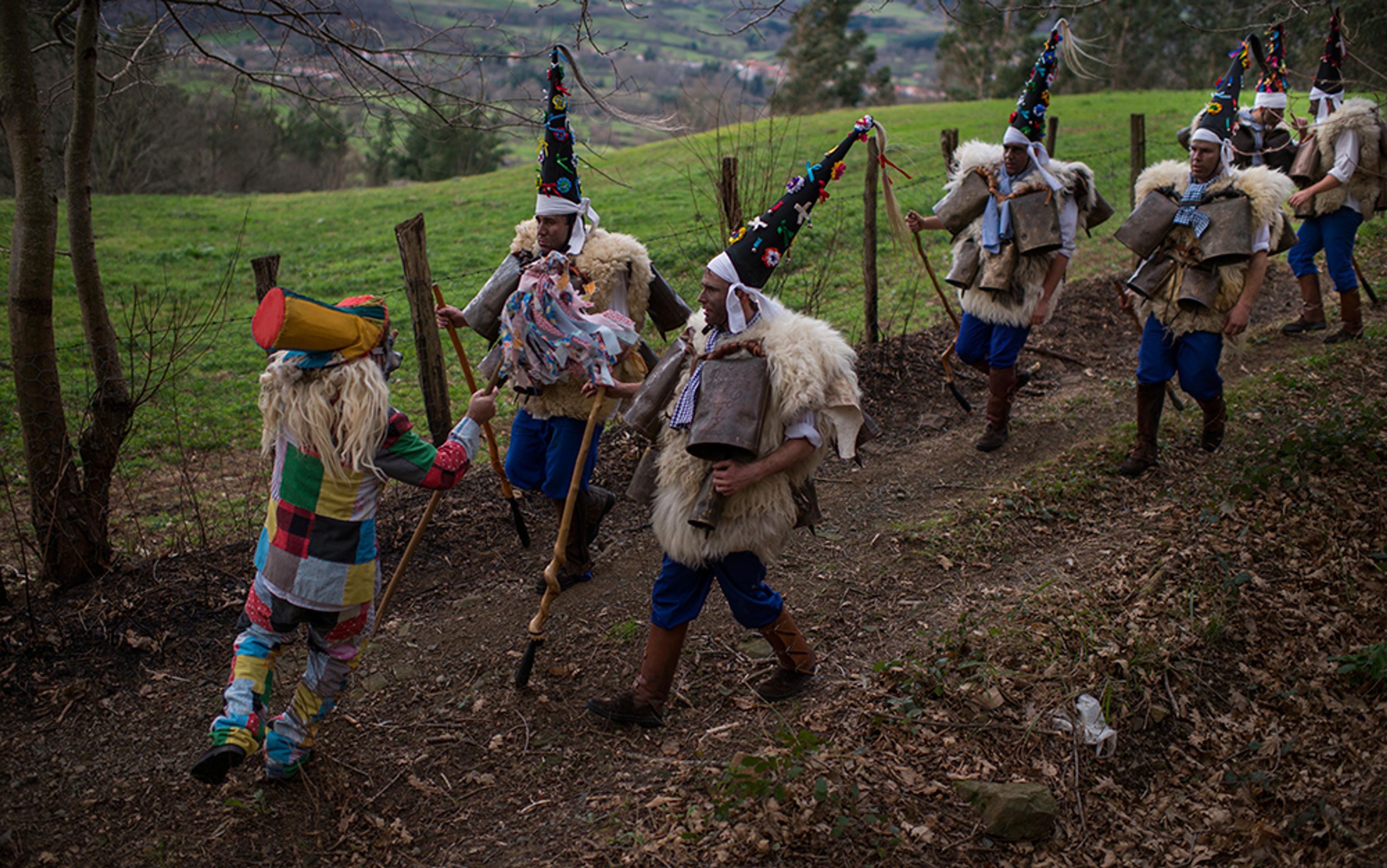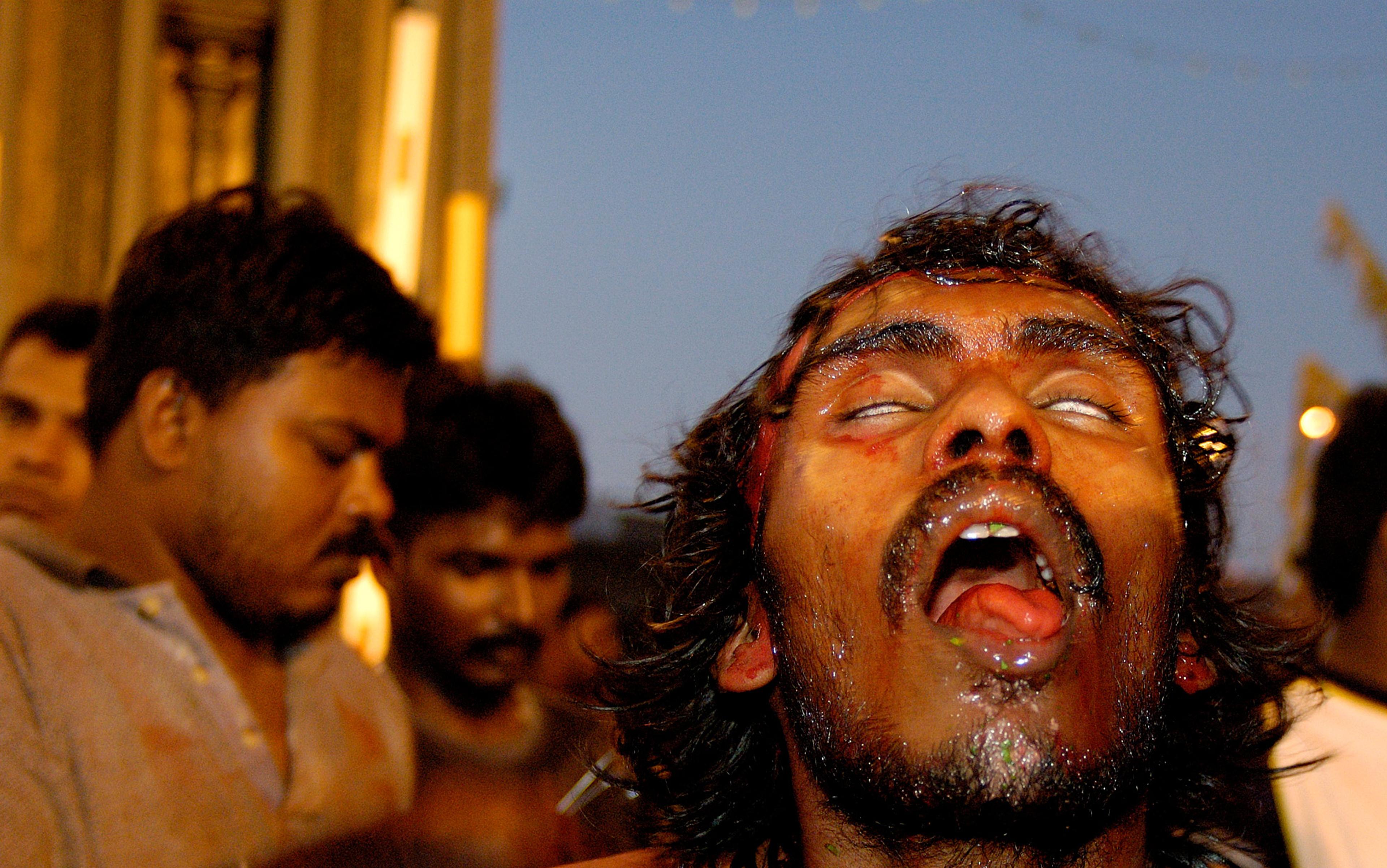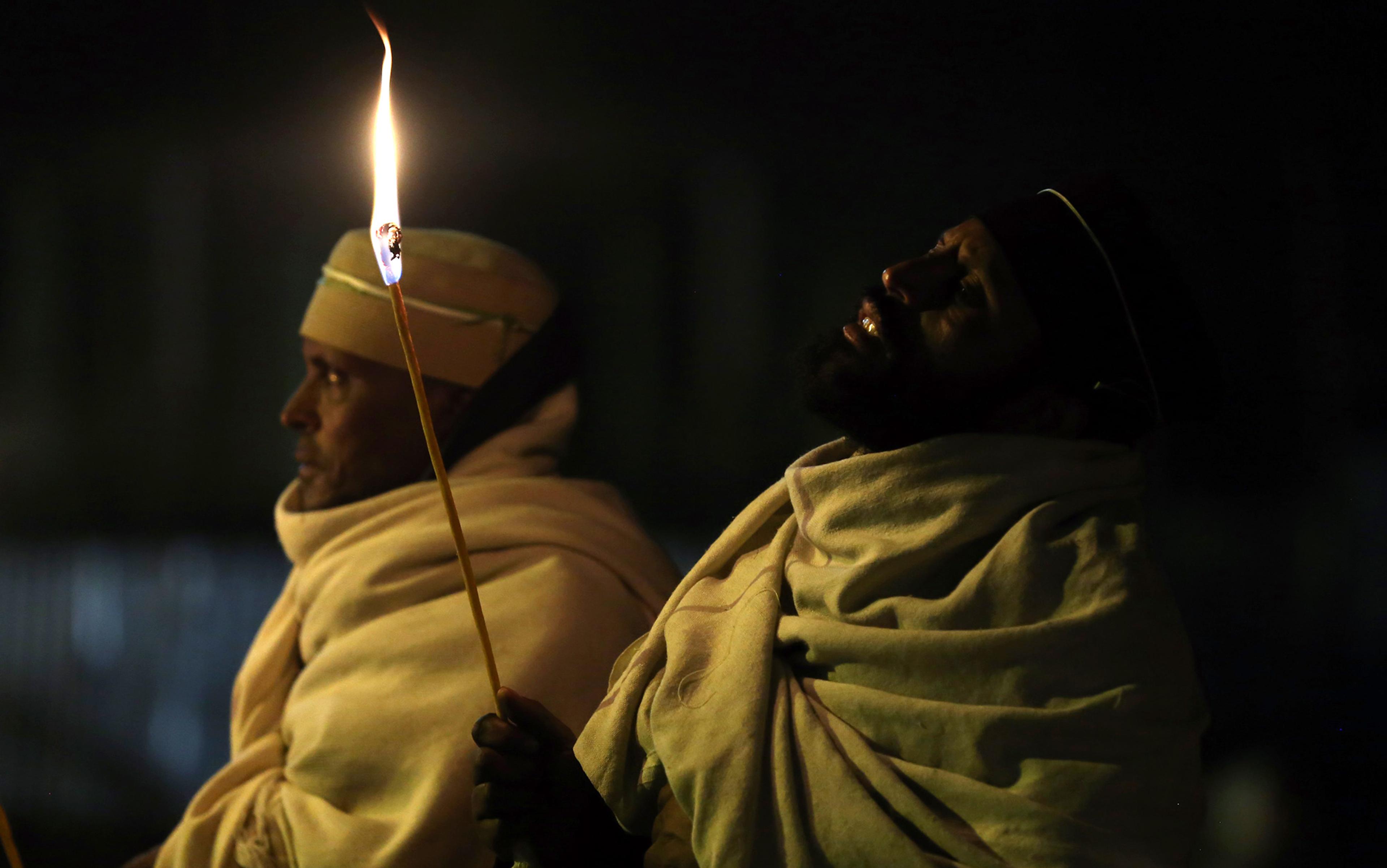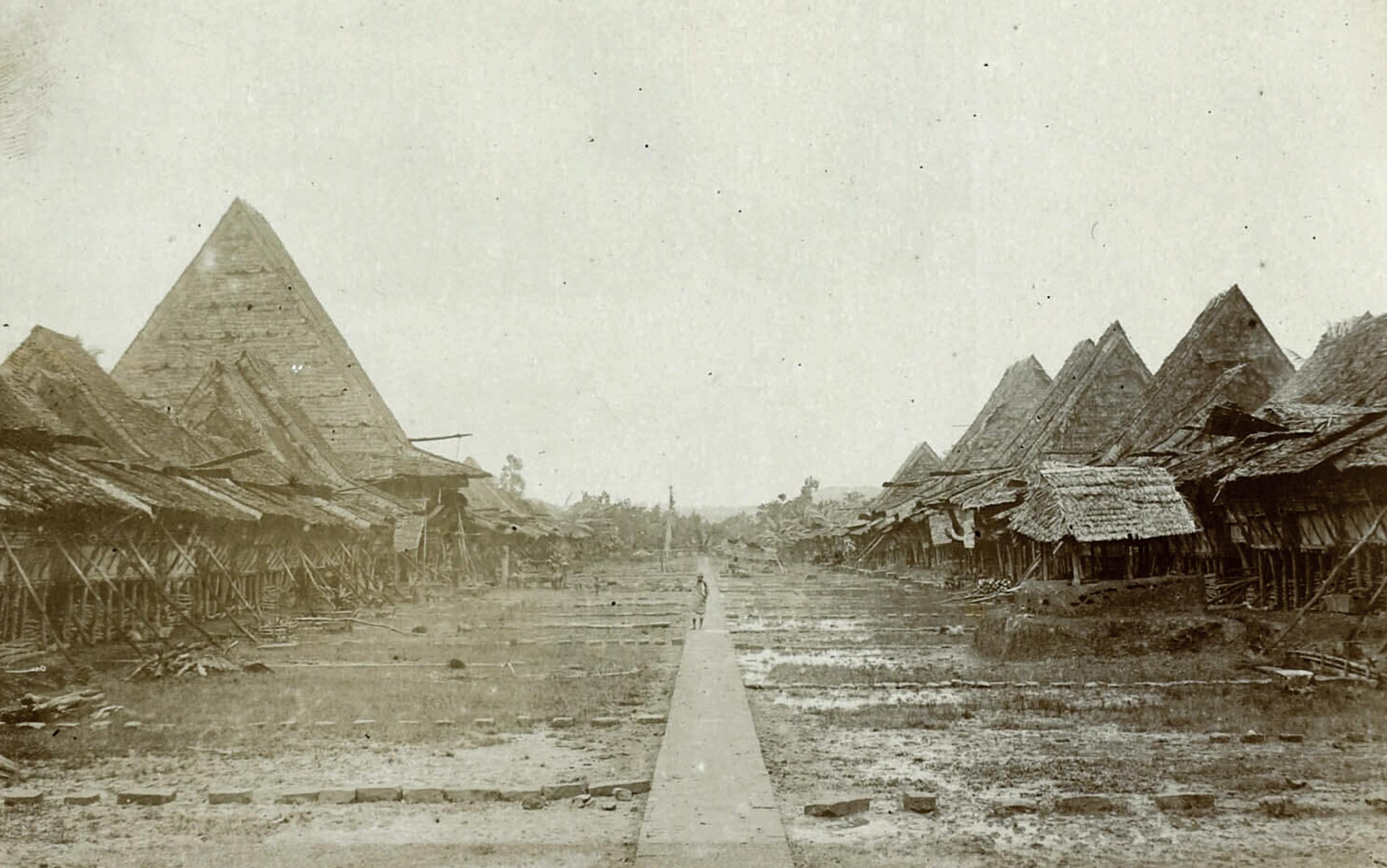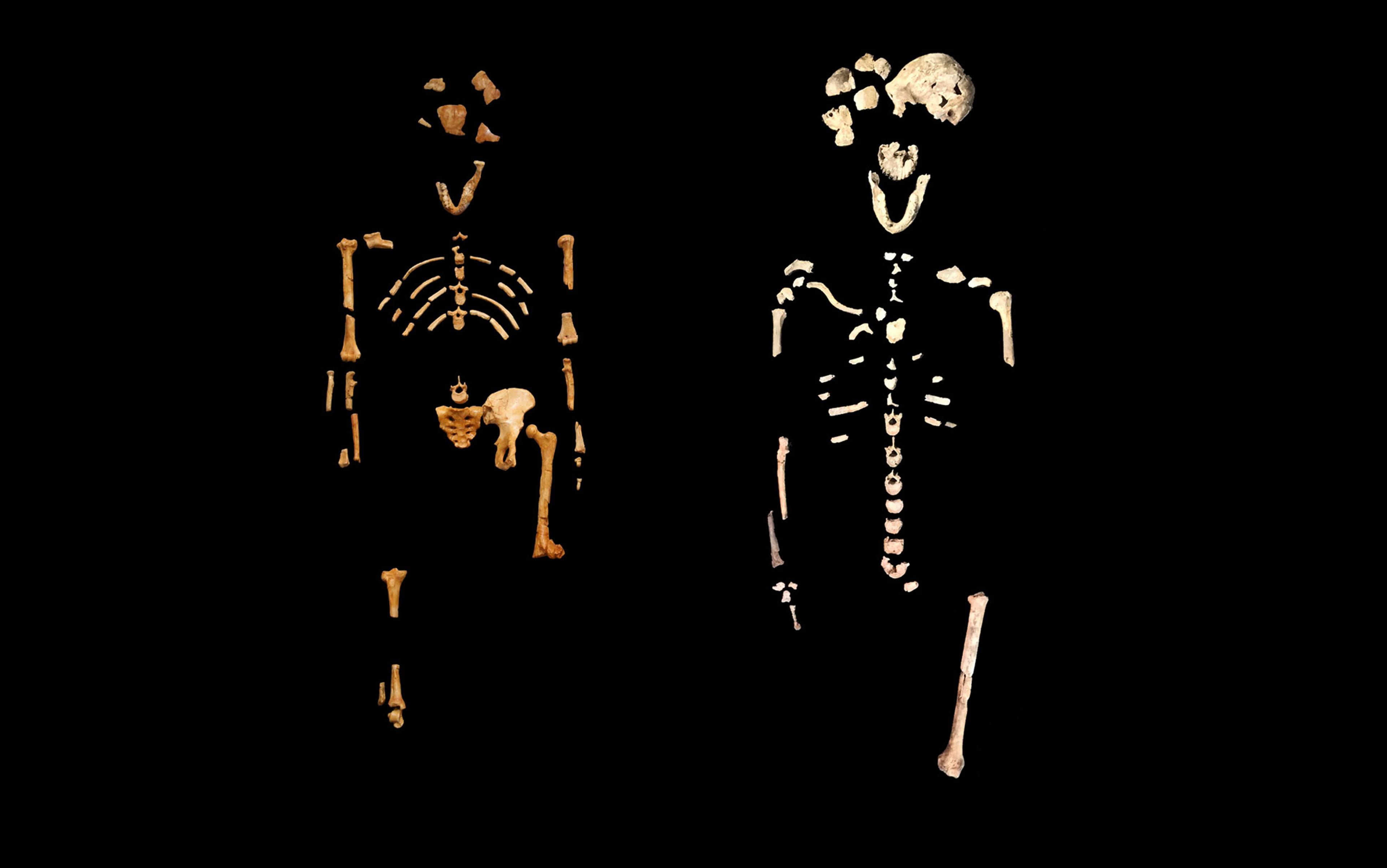My colleagues and I were pressed up against each other on the back seat of a police car as it wove through the narrow streets of Urfa, a medieval Turkish city nestled in the watershed of the Euphrates. We stopped in traffic. Somewhere behind a tangle of washing on the rooftops a baby was crying and a television was blaring. On the pavement a group of Kurdish youths stared at us. One hour earlier, near the excavations we had come to see, there had been killings. Some said the bomb was launched from over the border in Syria. Others said it was a Kurdish attack on the police. The policeman at the wheel glanced at the youths and then over his shoulder at us. ‘Bad people,’ he said.
I found myself wondering how many times that kind of sneering encounter had occurred in this ancient landscape, a cradle not only of civilizations but of the divisions between them. A minaret burst into song. In the distance, another joined in, then another. We turned a corner and the high fortifications of the city loomed into view. Two years before, I had stood at the top tracing ancient landmarks of the silk trade. Now the city gazed out at the troubled hills of an Arab Autumn.
Earlier that day, I had eaten lunch with an archaeologist living in Jordan. He viewed the sufferings of the Middle East through the lens of deep history. His eye twinkled when I pointed out this quirk. ‘Actually,’ he said, ‘I see it the other way around. Most people view the Middle East through the lens of very shallow history.’
We were in town with a group of scholars and scientists who were trying to reconstruct a world that blossomed more than 10,000 years ago. Some 15km away, Göbekli Tepe comprises a series of Stonehenge-like circles of stone slabs, faintly resembling giant phalluses. In fact, these stones were quarried much, much earlier than Stonehenge — some 12,000 years ago. And each spectacular ring of towering monoliths was probably buried within days or weeks of its completion. The sheer effort of human labour involved is mind-boggling. Nobody knows how it was done without bulldozers, winches, cranes, or even steel hand tools. And nobody knows why. What inspired ancient foragers to push their stone-age technology to the very limits, cutting 20-tonne stones out of the hillside, dragging them up to the summit and placing them in painstakingly dug holes several metres deep? Why carve exquisitely realistic high reliefs of animals into their sides, only to hide these staggering creations from view under a pile of rubble?
Strange objects — long stone knives, masks and other ritual regalia — lie tucked away from prying eyes, shrouded in darkness as surely as if they had been buried underground
Each T-shaped monolith, whatever else it represents, is a giant person: some of the stelae have arms and hands carved into them, roughly in proportion for a giant human figure. Between the markings, however, are reliefs of foxes, bulls, vultures, spiders and seemingly countless other species of fauna known to have roamed, wriggled and flapped around the late Pleistocene or early Holocene landscape some 12,000 years ago. Equally striking are the images not inscribed on the stones. Although these complex foraging peoples were just beginning to cultivate crops, there are no plants depicted at Göbekli. And with the exception of one carving of a headless skeleton and the eerie anthropomorphism of the monoliths taken as wholes, human figures are few and far between. These master carvers were very interested in animals.
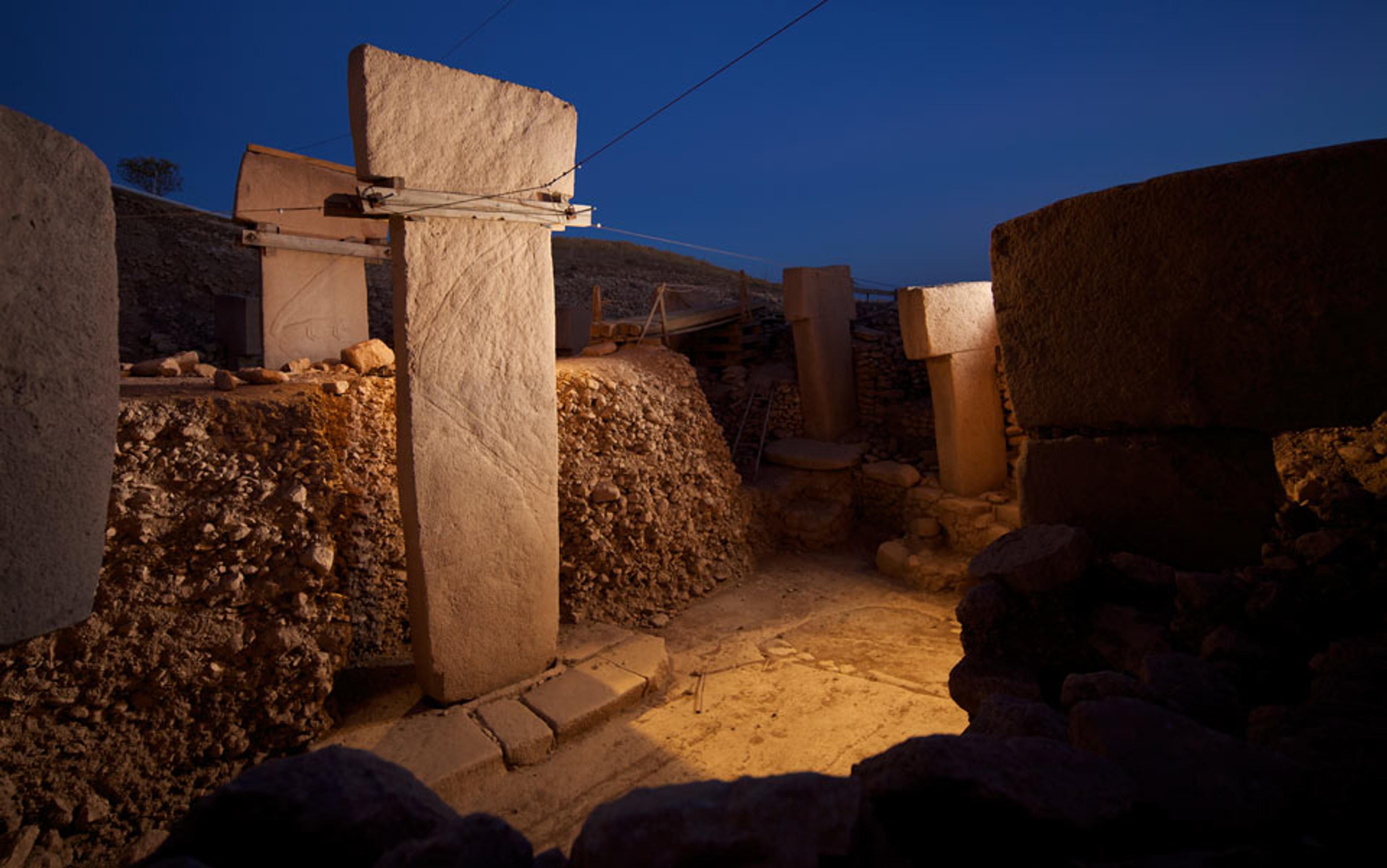
Buried treasures: monoliths at Göbekli Tepe. Photo by Vincent J. Musi/National Geographic Society/Corbis
A clue to the significance of this site lies far away in the Judean desert, hidden in a tiny cave. Strange objects — long stone knives, masks and other ritual regalia — lie tucked away from prying eyes, shrouded in darkness as surely as if they had been buried underground. The peoples of this age liked to hide and reveal powerful objects. They placed many of their dead under the floors of their houses, sometimes drilling down to retrieve particular bones, occasionally ‘refleshing’ them with clay or painting them with ochre before carefully laying them to rest again beneath the earth. At some ancient sites, perhaps most famously at the massive settlement at Çatalhöyük 650km west of Göbekli Tepe, people hid special objects in the walls as well as in the floors. Occasionally, these objects protruded or left visible bumps, signalling the hidden treasures beneath. Other times they were hidden without trace.
Despite controversy about Göbekli’s significance, a consensus is emerging among archaeologists that this was a hugely significant ritual centre: not a permanent home but a sacred place where people gathered at special times. Why they needed it and what it meant remain a mystery. I am part of a diverse team of scientists asked to help solve it. And my best guess goes to the very nature of ritual, a force in human affairs that can seem as vast, archaic and submerged as the stones at Göbekli Tepe themselves. So, let’s dig.
Imagine you are a five-year-old being led into a small office. A woman with a warm smile shows you an assortment of strange objects. Some of them are shiny. You feel like playing with them. That’s OK, that’s allowed. Soon the friendly lady takes the objects away and says she wants to show you a video. On the screen is another woman. She has an identical set of objects lined up neatly in a row and she’s doing odd things with them — she lifts one and taps it on another, then puts it back and takes something else, twirling it in a peculiar fashion before replacing it. This goes on for some time. Then the strange objects are pushed back towards you and the lady says: ‘It’s your turn.’ What would you do?
If you were a five-year-old, you would imitate at least some of the actions you observed in the video. No instruction would be necessary. And yet, the behaviour doesn’t appear to achieve anything. The psychologist Cristine Legare and I have been working together for several years trying to understand why young test subjects bother to copy it. Our starting point is that they treat it as a convention of some kind. That is to say, they adopt what we call ‘the ritual stance’, imitating without questioning the purpose of the actions.
In our experiment, however, the behaviour of the woman in the video is ambiguous. Children can’t be sure it if is oriented to a goal or not. A surprisingly simple shift helps them to decide: we just alter the last move in the sequence. If the woman puts the last object into a box, it looks like the whole procedure was just a ‘funny’ way of putting an object away. We call this the ‘instrumental condition’. On the other hand, if the objects all end up back where they were originally placed, the whole action sequence appears not to have any tangible purpose. We call this the ‘ritual condition’. When the start and end states are identical, children are more confident that the demonstration on the video should be interpreted as a kind of ritual. And guess what? They copy it much more faithfully, and are less inclined to try out variations on their own initiative.
Human populations living side-by-side tend to have a lot in common. In practical affairs, there might be little to tell them apart. Their rituals are a different story
If someone asked you to list the defining features of being human, you might cite our formidable linguistic prowess, our finely tuned moral sense, and our unrivalled capacity for creative invention. All these have no doubt played their parts in making us the globally dominant species that we are, enabling us to share ideas, form close-knit communities, and eke out an existence in an unprecedented range of environments. Yet an equally important factor in the success of our species has been our capacity for precise imitation. Copying other people is what creates the very possibility of complex culture, and cultural imitation is a universal human trait. Every person on the planet (barring those with certain cognitive deficits) is equipped to pick up the knowledge and skills nurtured by any culture that has existed. If a Palaeolithic infant time-travelled to the present, she would develop much like any other normal child, learning to read and write and to use all the advanced technologies of the 21st century.
In addition to technical skills, however, we also imitate behaviours where the link between what we do and some hoped-for outcome is much less clear — rituals being a prime example. People engage in ritual activities for all sorts of reasons: to commune with the divine, to mark changes in status, to bury the dead, and sometimes for no reason at all that anybody can remember. No matter what the goal is, however, the actual mechanisms by which rituals are supposed to work are typically inscrutable. There’s no clear causal process: you simply have to do things this way, and that’s that.
This has some remarkable consequences. Human populations living side-by-side tend to have a lot in common. They adopt the same basic techniques of production, use similar tools and natural resources, live in similar kinds of houses and so on. At the level of practical affairs, there might be little to tell them apart. However, their rituals are a different story altogether. Arbitrary conventions on how to achieve certain goals — placate the gods, or ensure an adequate crop — can assume any pattern: in straightforward physical terms, they don’t actually have to do anything. And yet they are far from impotent. Indeed, in social terms they can have very significant effects. To start with, they serve as admirable group markers precisely because they are of no use to those outside the group. And they don’t just demarcate people. Rituals also bind them together. How? And how far can they stretch?
In the late 1980s, my English wife and I went to live for two years in the rainforest of Papua New Guinea. As a doctoral student at Cambridge University, I had pledged to find out how people in this region lived off the land using traditional hunting and gardening techniques. This didn’t work out, though. People tried to teach me, but I could see after a while that their eyes were glazing over. What they really wanted to talk about was something much closer to their hearts: the end of this world and the beginning of a new world order.
Our hosts were members of an organisation calling itself the Pomio Kivung, which was founded in 1964. It taught that the dead would return, bringing with them all the wonders of Western technology. The rainforest would be flattened and huge tower blocks would rise from the earth. The living would peel off their black skins to find that underneath they were white. The rich people of the world would be united with the poor, and there would be no more childbirth, death, or disease.
In order to bring about this miracle, the ancestors had to be persuaded that the time was right. Every day, thousands of followers prepared offerings to their dead and laid them out in special temples. It was said that the ancestors were gratified by the temple rituals. However, they refused to accept the offerings whenever the Pomio Kivung laws were flouted, and the laws were so numerous and exacting that it was almost impossible to avoid slipping up. Thus the offerings were often rejected. The ancestors, though invisible, constantly watched over the living, checking up on them.
The returning ancestors were expected to take the physical appearance of white men and women. As a young, white-skinned anthropologist whose favorite pastime was to follow people around writing down everything they did and said, it didn’t take long for people to put two and two together. Nobody had ever heard of white people going native in this part of the jungle; there had been missionaries and colonial patrol officers but they only ever passed through. Rumors of returning ancestors might have helped to trigger what happened next.
These new rituals had elements of joyfulness, even ecstasy, but I was struck by the fact that many of them involved considerable discomfort
A young man, Tanotka, had been running a high fever. There was nothing unusual about that — malaria was unavoidable. The worst kind induces delirium before it kills you, and Tanotka had the worst kind. Some of his ravings were clearly nonsense. Yet he also said some things that sounded significant, perhaps even divinely inspired. Word began to spread that Tanotka had a special kind of sight, that he’d been taken over by an ancestor, that he had already turned white underneath his black skin, that he was turning into a living god. After he recovered from the delirium, Tanotka emerged as the leader of a breakaway cult within the larger Pomio Kivung movement.
I soon gave up collecting data on hunting and gardening and instead devoted my time to studying the Pomio Kivung. The full story of Tanotka’s rise and fall is told in my book Inside the Cult (1995). Suffice it to say, his splinter group performed a series of climactic rituals to welcome back the ancestors and usher in a time of plenty. These new rituals had elements of joyfulness, even ecstasy, but I was struck by the fact that many of them involved considerable discomfort. Some of it could have been incidental, yet many of the new rituals involved more extreme forms of suffering. There were vigils where followers were corralled into a specially constructed house and, to avoid breaking with group solidarity, forced to sit in their own excrement and vomit waiting indefinitely for the ancestors to return. Some of the new rituals were based on more ancient ones that traditionally entailed laceration of the tongue with a sharpened leaf, insertion of cassowary bone at the base of the spine, and other tortures and privations, too numerous to recount here.
I realised that the Pomio Kivung had two very different sides. On the one hand, it was a large movement encompassing thousands of people in many villages, some of whom had never actually met one another. I saw this as its ‘doctrinal mode’ because it emphasised preaching about the laws at frequent and typically rather boring meetings. But then there were splinter groups. These tended to occur no more than once every five years in any given village. Their rituals were unique, intense, and often acutely unpleasant. I called this aspect the ‘imagistic mode’, partly because the shared experiences left indelible images in people’s memories.
The splinter group led by Tanotka eventually collapsed, as most of them did. Having destroyed all their livestock and eaten all the food in their gardens, there was nothing for it but to accept the charity of those more skeptical kinsmen in the forest who had elected not to join the vigils. Yet hardly anybody abandoned the larger Pomio Kivung movement. On the contrary, I was surprised to see that overall commitment to the belief system had actually increased as a result of Tanotka’s influence. Not that there weren’t awkward details to explain away. The non-arrival of ancestors was attributed to the intervention of evil spirits and the failure to conduct the rituals correctly. A slightly thornier problem for some might have been the fact that, towards the end of our time in the rainforest, my wife bore us a child. The official doctrine was that ancestors cannot reproduce, so this might be expected to have proven my point all along: that we were no different from any of the white-skinned foreigners who turned up on the Catholic missionary’s patrols. Then one person told me that what had really amazed him was that they had been so misguided — clearly ancestors could bear children after all.
These experiences in the rainforest changed my life. I spent the next 20 years investigating the distinction between doctrinal and imagistic dynamics across a vast range of different religious groups. Repeatedly it seemed that groups who shared bad experiences, painful or frightening rituals in particular, were bound tightly together at a local level. Groups who shared more regularly repeated rituals and doctrines were bonded on a much larger scale, even if less intensely. These patterns didn’t just recur across the world today; they were also woven into the history of religions stretching back into the archaeological past. Why?
There have, of course, been many theories about how ritual actually works. At the Ritual, Community and Conflict project that I lead at the University of Oxford, one of our main hypotheses is as follows. The very fact that ceremonial actions are not intelligible in practical terms means that we can endow them with many possible functions and meanings. Furthermore, if we don’t know very much about what others are thinking, we tend to believe that what is personally meaningful about the experience of joining in is shared by everyone else. This is the ‘false consensus bias’, well-documented in social psychology.
These two facts together explain why painful or frightening (in the jargon, ‘dysphoric’) rituals — such as traumatic initiations and hazing practices — lead to bonding. Whatever each performer thinks or feels about the experience, they all assume that the other participants feel the same as them. The same goes for non-ritual experiences, too: the more painful or horrifying it is, the stronger the effect. If we are hurt in a plane crash, we might dwell on it for years afterwards, considering how it changed our lives and wondering why it happened, how it could have been different and so on. Discovering other people who share this experience can be powerful: they seem uniquely placed to understand us in a way that others simply can’t. In fact, we might go so far as to say that people have no right to comment if they haven’t been through what we have been through. Ritual is able to work with these feelings – provoking them as part of an intense experience of bonding with a group.
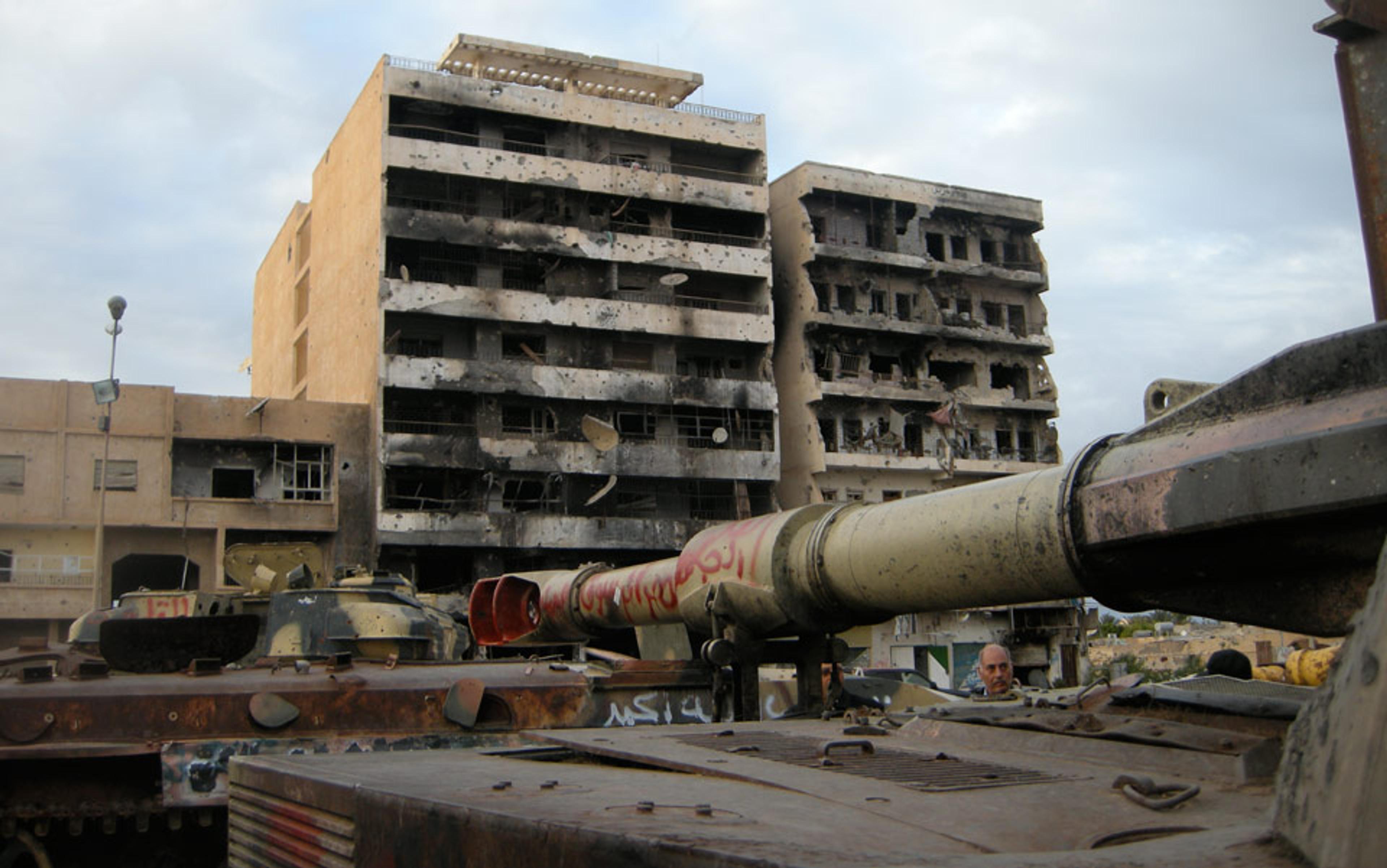
Endless rows of burned-out tanks: the aftermath of the Libyan uprising. Photo by Harvey Whitehouse
To study these processes up close, Brian McQuinn, a doctoral student at the Centre for Anthropology and Mind at the University of Oxford, went to live among revolutionaries in Misrata, Libya. This was during the uprising that led to Gaddafi’s overthrow. Seeing the formation of rebel groups from the inside, McQuinn was able to watch how the shared ordeals of military brigades served to bind them together. In December last year, in the aftermath of the revolution, I joined him in Libya and we met some of the military leaders and fighting units.
The devastation wrought by the war was immediately evident on my arrival. Every building I could see from the plane as it taxied to the gate was peppered with bullet holes. My fellow passengers were climbing over one another to retrieve their luggage. McQuinn dragged me from the scrum and led me to his car. It too had a bullet hole in the passenger door. I picked up a dead shell from beside my feet as we drove away.
McQuinn avoids caffeine, knowing he has a tendency to talk too fast. But today it seemed he had consumed several cups of coffee. We had a meeting with a Mr Joha, he told me, head of the revolutionary forces in Misrata, the perfect way to get our work started, but first I had to meet Mohammed our translator… His voice grew distant as I took in the damage to the buildings around me, the endless rows of burned-out tanks, the holes in the road, the long rows of ragged palms, shot to ribbons.
We drove up to a large mansion with bollards at the gate. McQuinn spoke briefly to the guards, each strapped up with an ammo belt and carrying an automatic weapon. They hauled the roadblocks to one side. As we drove through the perimeter wall, McQuinn turned to me. ‘Mr Joha is very powerful,’ he said. ‘Please don’t insult him or we’re both in a lot of trouble.’
Inside the mansion, young men with rifles sprawled on sofas smoking, occasionally laughing loudly. As we passed, they fell quiet, following us with their eyes. We found Mr Joha at a long boardroom table, capable of accommodating perhaps 20 people. To his left and right were leaders of revolutionary brigades, wreathed in cigarette smoke. McQuinn, Mohammed and I were invited to sit. Mr Joha stared fixedly at me as he delivered a long speech in Arabic. Mohammed translated. It began: ‘We would like to thank you for sending us your son, Brian…’
McQuinn is not my son. He’s my doctoral student and is less then 10 years younger than me. But I decided it was best not to argue. In any case, I told myself, kinship psychology was one of the things we were there to study. Before I could make any notes, however, Mr Joha’s speech was over and it was my turn. I mumbled something about my gratitude for the hospitality shown to my son and then asked if he and his colleagues would be kind enough to answer a few questions of anthropological interest. Mr Joha’s stare intensified. ‘First,’ he said, ‘I have a question for you. When news broke around the world about the revolution in Libya, had you ever heard of… Misrata?’
This sounded like a trick question. I considered what McQuinn had said about not annoying him. But the truth was that I had heard of Misrata. One of my most distinguished predecessors as head of the anthropology department in Oxford was Sir EE Evans-Pritchard. During the Second World War, Evans-Pritchard had served as an officer for British military intelligence in Libya, and via his voluminous writings I had learned about a war hero in Misrata. That man, it turned out, was Mr Joha’s grandfather. The atmosphere brightened a little upon this discovery; Mr Joha proceeded to share many examples of how shared dysphoria – or deeply unpleasant experiences – can bind a group of fighters together.
One day a cyclone hit Australia, at which point they sent a large portion of their wealth to help the victims recover. In doing so, they were reaching out to humanity at large
His stories – some too grisly to recount – were typical for revolutionaries in Libya. Almost all of them faced sustained attack while tending the wounded and dying. Many were trapped in holes, in nightmarish conditions, with little chance of escape. Many died. Those who survived found they shared a special bond. Social psychologists refer to this kind of bond as ‘identity fusion’, and William Swann, professor of social and personality psychology at the University of Texas, has developed some ingenious survey techniques to measure it.
Swann and his colleagues have shown that being fused with a group is different from simply identifying with it. We all have both personal identities and social ones. When you connect with a group (such as the Conservative Party, for example), the activation of your identity as a Tory seems to lessen your identity as an individual. You ‘lose’ yourself in the group. But if you are fused with your party, the boundary between your personal and social selves becomes porous. It’s hard to know where you end and the group begins. Consequently, if somebody belittles the Tories, you experience it as a personal insult. And if a member of your party is physically attacked, your actions to protect them feel like self-defence. McQuinn’s work with Libyan revolutionaries suggests that their experience reflected this: the more horrible the experiences they shared with otheres, the stronger the resulting fusion of identities.
How does any of this relate to rituals? Well, we think dysphoric rituals are a bit like coming under fire in a warzone, except that they are more powerfully bonding, partly because they cannot be explained in any simple causal way. The range of interpretations that one can place on a painful or unpleasant ritual is inexhaustible: it sucks you into an interpretive vortex. In fact, our lab experiments suggest that one’s sense of a ritual’s significance actually increases over time, rather than decaying. In communal ceremonies it is usual to witness others undergoing the same experience, and to imagine them sharing the same rich interpretive process. The forces shaping one’s own sense of self are recognised in a special cohort of others, causing members to ‘fuse’.
Back in Oxford, building on research that I began with the psychologist Rebekah Richert in Belfast during the Troubles, an experimental research team led by Jonathan Lanman and Ryan McKay is currently trying to tease apart those aspects of unpleasant experience that contribute to identity fusion. In our laboratory at the Institute of Cognitive and Evolutionary Anthropology, we get volunteers to participate in two versions of an artificial ritual. One set of participants gets a fairly easy ride: they are invited to copy actions in a video while listening to a soundtrack of pleasantly babbling infants. The other set of participants have to perform the imitation tasks while listening to a high-volume audio recording of screaming babies. Trust me, this is really unpleasant. The question is, does the bad experience lead participants to feel more bonded and to cooperate with one another more readily? And do these effects increase over time, as seems to be the case in many real-world situations? If not, it might be that the soundtrack is insufficiently awful to bring about the sort of fusion that interests us, in which case we have a problem: we come up against the ethical limits for this sort of research. If we do see the desired effect, though, a piece of the puzzle will have slotted into place.
Most of what I’ve written about so far is, in the scheme of things, small-scale. Libyan revolutionary brigades and religious splinter groups in the jungle might experience intense identity fusion, but those bonds are confined by their nature to just a few individuals. Ritual, on the other hand, has evolved to operate on ever-larger scales. It extends across tribes, cities and nations. Moreover, in some cases, a sense of bondedness, underpinned by ritual, can even extend to humanity at large.
Consider the doctrinal mode of the Pomio Kivung. My friends in the movement had suffered exploitation and domination by a succession of Western colonial powers. Yet they wanted to be reconciled in peace and kindness with their oppressors; they pictured their ancestors with white skins and they longed to be reunited with them. A commitment to distant white folks was often expressed in action. For example, they carefully set aside what little money they could get through small-scale cash cropping, until one day a cyclone hit Australia, at which point they sent a large portion of their wealth to help the victims recover. In doing so, they were reaching out to humanity at large.
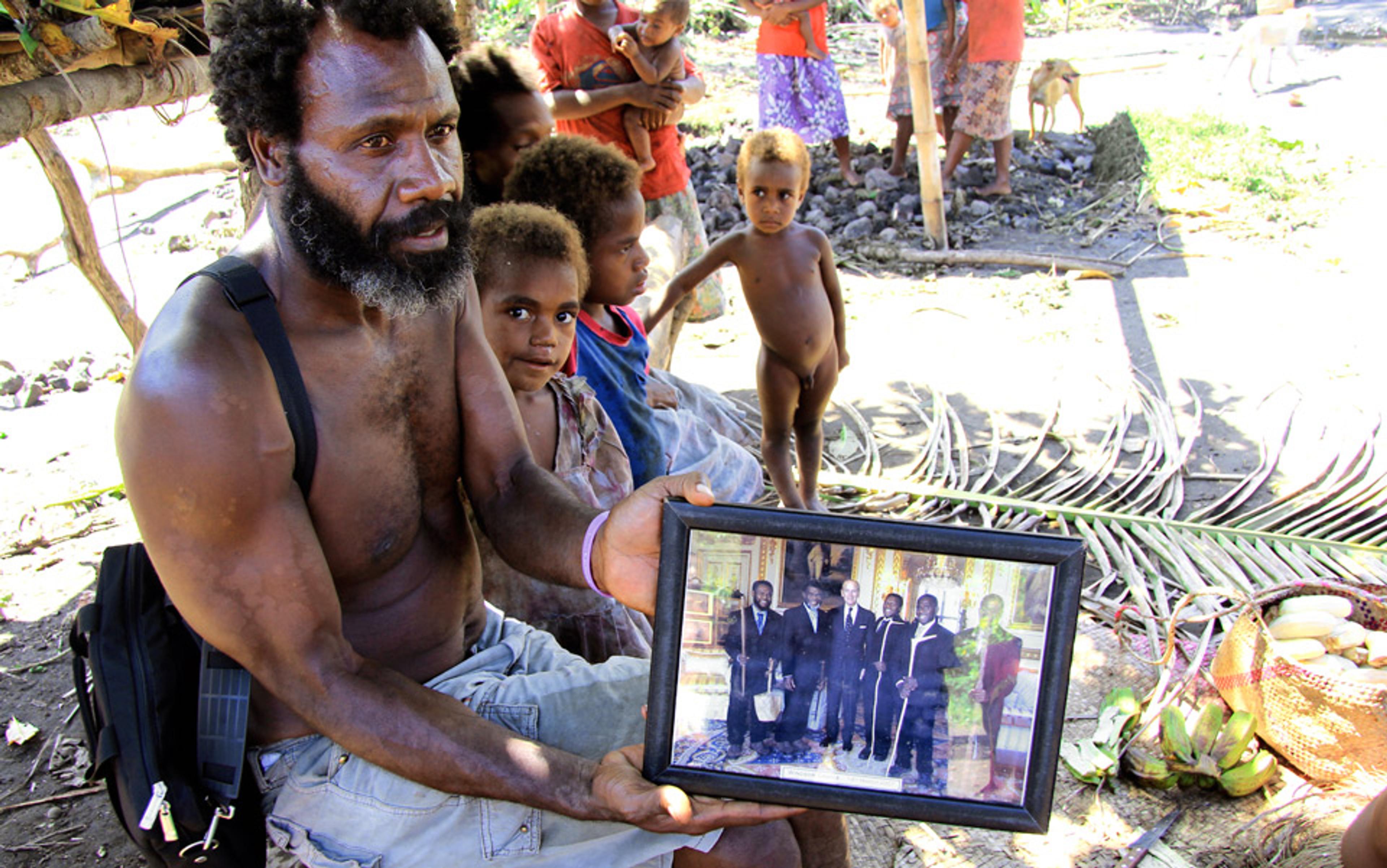
The unity of nations: Tanna islanders display a photo of their meeting with Prince Philip at Buckingham Palace. Photo by Harvey Whitehouse
Earlier this year, I went the South Pacific island of Tanna in Vanuatu to study a similar universalist tendency. The islanders’ vision of a brotherhood of man admittedly has some odd elements. Their veneration of Prince Philip, for example, is sufficiently bizarre (to the British public, at least) that a Channel 4 film crew flew them from their village in the rainforest to meet various natives of the UK, culminating in an audience with their revered royal at Buckingham Palace. On their tour of the UK, the islanders discovered many things to admire, but they were also dismayed to find that the most important community gatherings were focused around something called ‘the pub’ — a place where, far from listening to one another in an orderly fashion to resolve matters of general importance, everyone shouted at once. Surely, they concluded, nothing of importance could be decided in such a forum.
The series made entertaining television. But it also contained a serious message from Tanna. The message was this: we need to create a unity of nations through peace and kindness. The intended recipients of this message no doubt thought it was rather nice, if a little naive. I don’t think they actually understood.
Humans are as ritualistic today as they have ever been, whether in families, schools, workplaces, governments, or international relations
Back on Tanna, the people I met ran to collect photographs of their meeting with Prince Philip, eager to tell stories of life in the UK that the documentary team had not been able to gather or broadcast. There was, however, one theme that kept recurring in these stories that caused the islanders evident sadness. That was the phenomenon of homelessness: people destitute on the streets, ignored by passers-by as if they were not really human beings at all. It is hard to convey how distressing this spectacle was for my friends from Tanna. It was one of the main reasons why they politely offered us a message of kindness: they thought we needed it.
In order to contribute to this universal bond between humans, many people on Tanna have been experimenting with new rituals. These are designed to prepare the way for the unification of human nations through reciprocity and kindness. Through ritual, they hope to transcend the divisions between humans. They aren’t the first to have had this idea, of course. Jesus of Nazareth, for example, had a similar vision, even if efforts to spread his teachings have been all too often directed at silencing the ideas of competing visionaries. Crusades and religious wars have, ironically, been one of the main outcome of efforts to unify human ritual systems, with often horrific results. It’s not clear that the intense bonds of small-scale societies can scale up into much larger, more hierachical ones. However prehistory has some clues as to what happens when ritual moves from the intensity of personal bonds to the impersonal and doctrinal.
Ritual is popularly misconstrued as an exotic, even quirky topic — a facet of human nature that, along with beliefs in supernatural agents and magical spells, is little more than a curious fossil of pre-scientific culture, doomed to eventual extinction in the wake of rational discovery and invention. Nothing could be further from the truth. Humans are as ritualistic today as they have ever been. This is not a comment on the changing fortunes of organised religion in different parts of the world (growing and spreading in some places while undoubtedly declining in others). It is a point about the profoundly ritualistic character of all human cultures, whether in families, schools, workplaces, governments, or international relations.
Rituals persist even where gods do not. Even the most secular political systems ever devised — for instance, those under the sway of historical materialism and its vision of a Communist utopia — were as devoted to ritual as any in human history. Meanwhile, back in Çatalhöyük, that place of buried secrets, we can see the traces of the evolution of ritual laid out beneath our feet.
The site, one of the largest Neolithic settlements in Southwest Asia, was discovered in 1958 by the British archaeologist James Mellaart. It was founded around 7300 BC and occupied until at least 6200 BC, providing a home to thousands of people who lived side-by-side in closely packed houses. Over the past few years I have been working with the director of the excavations, Ian Hodder, together with the psychologist Quentin Atkinson, to help a team of archaeologists reconstruct the ritual lives of the peoples who established the settlement. What we have found is that, as the rituals changed, so did the human groups they created and underpinned.
In the early phases of the site, collective rituals were rare occasions of high emotional excitement. The scale and frequency of their feasting events can be seen in the type and density of animal remains in the midden deposits. These formidable hunters were using stone projectile points to bring down very dangerous animals: wild bulls, for example, much larger and more ferocious than our domesticated variants. They also left behind exquisite paintings of armed men surrounding these animals, apparently teasing and baiting them before the kill. Heart-pumping rituals of this kind would have been necessary to fuse intimate bands of hunters and explorers, whose heroic deeds were memorialised in the trophies of animal heads and obsidian blades found in their houses.
The ancient hunter-gatherers of Western Asia were bound together through intense and esoteric rituals of countless hunting-feasting cults
As agriculture took root during the Neolithic, the need for such highly fused groups disappeared. Spheres of cooperation had to extend across much larger groups, operating more complex systems of production and exchange. Inter-group rivalries had to be tamped down in the interests of the larger collective. And so we see the emergence of regular collective rituals, including much smaller and more frequent feasting events using the meat of domesticated sheep and goats. Common identity markers spread widely, for instance in the form of stamp seals used for body decoration and more standardised pottery designs. Face-to-face fusion declined and larger social identities took over.
When societies all over the world become more complex, we expect to find religious rituals becoming more routinised. We expect ritualised ordeals to be less widespread, doctrine and narrative more standardised and more universalistic, and religion more hierarchical and professional. Small, tightly bonded groups with dysphoric rituals are a threat to larger societies: they create opposing coalitions, and so we expect they will be ‘selected out’ of the cultural repertoire, at least for the population at large, or relegated to confined organisations — militaries, for example.
The much more frequent rituals typical of regional and world religions sustain different forms of group identification. These will seem tailored to the kinds of collective action problems presented by interactions among strangers. As rituals become more frequent, however, we anticipate that they will become less stimulating emotionally. They might become tedious. We expect these new ritual systems to convey propositional information about supernatural beliefs, using repetition to drive the message home. Costly displays, such as animal sacrifices or monetary donations, will signal commitment. We expect a few doctrinal religions to achieve numerical dominance over local cults.
Göbekli Tepe in Southern Anatolia represents the earliest stirrings of just such a transition: firstly to much larger agricultural societies and, ultimately, to the great Bronze Age civilisations of the Levant and Mesopotamia. The ancient hunter-gatherers of Western Asia were bound together into small groups, united through the intense and esoteric rituals of countless hunting-feasting cults. These cults focused on the fertility and renewal of wild animals and humans, forging bonds through intense initiations and heroic adventures in pursuit of exotic trophies and obsidian. Göbekli provides a window into the flowering of this glorious age.
But in the latest stages of activity at Göbekli, the monoliths become smaller. Eventually people stopped making them at all, and the site was left undisturbed for millennia. It was not immediately forgotten. Nevertheless, as people became increasingly dependent on cultivated plants and domesticated animals (sheep, goats, pigs, and cattle), the cosmological mysteries that had held them spellbound for millennia became the stuff of legend. As farmers, the descendants of Göbekli celebrated their growing mastery of the natural world in an explosion of exquisite arts and technologies (elegant decorative pottery, for example, and two-storey houses). No longer fused with local cults, they identified with a unified regional culture. For a while, they remembered their glorious hunting past and common ancestry through more routine rituals, festivals, and narratives. Eventually, though, even the mythology faded and people forgot what lay buried in the mounds of Göbekli Tepe. In the historical (as opposed to pre-historical) world that followed, tribal kingdoms became empires and sacred narratives became orthodoxies.
Most of us are the products of this history. We use rough-and-ready guides to determine whom to trust and whom to hate. Those Kurdish youths I saw in Urfa knew they hated the police because of the insignia they bore. Their hatred was reciprocated, on similar social cues.
Very little of the inter-group hatred we observe in the world today is based on knowledge of the enemy as real people. And the groups with which we identify are made up, for the most part, of people we’ll never meet. Still, we haven’t forgotten our prehistoric ways of being bound together in groups. In times of desperation, we remember it best: for example, when the guns of a dictator are turned against us.
The revolutionaries I met in Libya were fused into small brigades, rather like ancient hunter-gatherers. They united in the face of adversity as tightly as any family, but they also extended this feeling of unity to larger social identities, such as the newly liberated state. In the wake of their suffering there was an extraordinary opportunity for collective action. In those heady days last year, McQuinn’s extensive interviews with revolutionaries revealed the weakening of old divisions and an unprecedented commitment to the country as a whole. Alas, this potential was wasted. At the end of the war, the groups that mattered on the ground, and the leaders to whom they looked for inspiration, were almost unknown to the international community, including the UN. Their collective unity was largely squandered in the political struggles that followed the revolution.
A couple of months after I left Libya, I was dozing amid a convivial crowd at the edge of a village meeting ground on the island of Tanna. Some men, naked except for their elaborate penis sheaths, drank kava and talked politics. I heard the word ‘Misrata’ and sat up in surprise. One of the men said he had been listening to the radio and was sorry to hear stories of revenge killings and fears of greater instability to come. As he relayed what he had heard, the men moaned in sympathy. Suddenly I realised the speaker was weeping.


